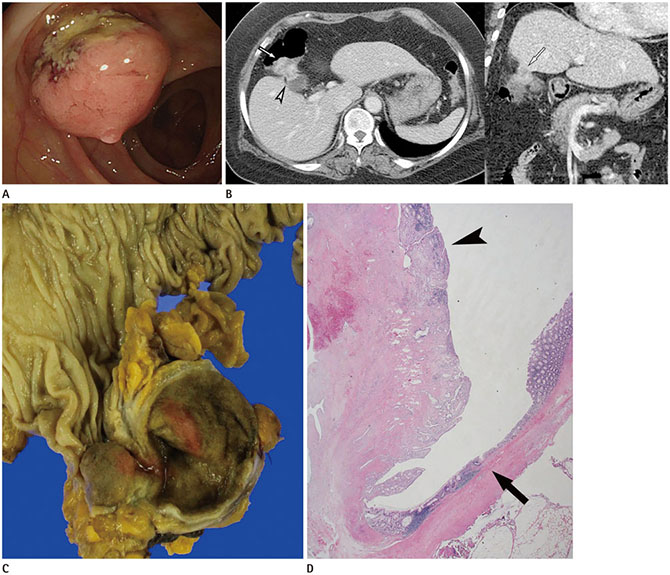J Korean Soc Radiol.
2018 Nov;79(5):290-293. 10.3348/jksr.2018.79.5.290.
Localized Adenomyomatosis of Gallbladder Mimicking Advanced Hepatic Flexure Colon Cancer: A Case Report
- Affiliations
-
- 1Department of Radiology, Ajou University School of Medicine, Ajou University Hospital, Suwon, Korea. kbh@ajou.ac.kr
- 2Department of Pathology, Ajou University School of Medicine, Ajou University Hospital, Suwon, Korea.
- 3Department of Gastroenterology, Ajou University School of Medicine, Ajou University Hospital, Suwon, Korea.
- KMID: 2422908
- DOI: http://doi.org/10.3348/jksr.2018.79.5.290
Abstract
- Localized forms of gallbladder adenomyomatosis are rarely polypoid and may mimic gallbladder cancer. Herein, we present a unique case of polypoid gallbladder adenomyomatosis penetrating the colon and preoperatively misdiagnosed as advanced hepatic flexure colon cancer.
Figure
Reference
-
1. Miyazaki K, Tsutsumi N, Sasatomi E, Kitahara K, Mori M, Tokunaga O, et al. Benign gallbladder lesions mimicking cancer infiltrating the liver. J Hepatobiliary Pancreat Surg. 1994; 1:273–279.
Article2. Gerard PS, Berman D, Zafaranloo S. CT and ultrasound of gallbladder adenomyomatosis mimicking carcinoma. J Comput Assist Tomogr. 1990; 14:490–491.3. Mellnick VM, Menias CO, Sandrasegaran K, Hara AK, Kielar AZ, Brunt EM, et al. Polypoid lesions of the gallbladder: disease spectrum with pathologic correlation. Radiographics. 2015; 35:387–399.4. Levy AD, Murakata LA, Rohrmann CA Jr. Gallbladder carcinoma: radiologic-pathologic correlation. Radiographics. 2001; 21:295–314. questionnaire, 549-555.
Article5. Landmann RG, Weiser MR. Surgical management of locally advanced and locally recurrent colon cancer. Clin Colon Rectal Surg. 2005; 18:182–189.
Article6. Glenn F, Reed C, Grafe WR. Biliary enteric fistula. Surg Gynecol Obstet. 1981; 153:527–531.7. Haff RC, Wise L, Ballinger WF. Biliary-enteric fistulas. Surg Gynecol Obstet. 1971; 133:84–88.8. Costi R, Randone B, Violi V, Scatton O, Sarli L, Soubrane O, et al. Cholecystocolonic fistula: facts and myths. A review of the 231 published cases. J Hepatobiliary Pancreat Surg. 2009; 16:8–18.
Article9. Ha GW, Lee MR, Kim JH. Cholecystocolic fistula caused by gallbladder carcinoma: preoperatively misdiagnosed as hepatic colon carcinoma. World J Gastroenterol. 2015; 21:4765–4769.
Article10. Mann CD, Johnson NA, Metcalfe MS, Neal CP, Harrison RF, Berry DP, et al. Cholecystobronchial fistula secondary to adenomyomatosis of the gallbladder. Ann R Coll Surg Engl. 2007; 89:W14–W16.
Article
- Full Text Links
- Actions
-
Cited
- CITED
-
- Close
- Share
- Similar articles
-
- Adenocarcinoma Arising in Segmental Adenomyomatosis of the Gallbladder: A Case Report
- Synchronous Cancers of Hepatic Angiosarcoma and Gallbladder Adenocarcinoma, Mimicking Gallbladder Cancer with Hepatic Invasion: a Case Report
- Focal Thickening at the Fundus of the Gallbladder: Computed Tomography Differentiation of Fundal Type Adenomyomatosis and Localized Chronic Cholecystitis
- Report of a Case of Adenomyomatosis of Gallbladder
- Hepatic Arterial Infusion Chemotherapy Using the Port System in Advanced Gallbladder Cancer


